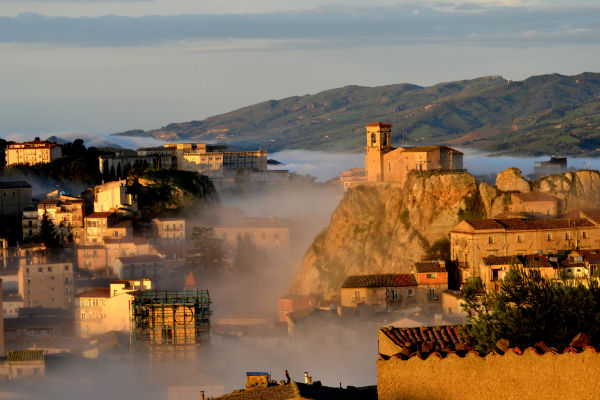Nicosia vanta antiche origini. Sotto i Normanni raggiunse il periodo del massimo splendore. Cara ai sovrani che in essa amarono soggiornare, fu presente con due delegati al Parlamento Generale di Foggia, su invito di Federico II.

Nonostante le gravi crisi dovute ad epidemie ed a calamità naturali, la città non si arrese mai. Nel corso dei secoli ospitò artisti di chiara fama la cui presenza è documentata dalle opere che abbelliscono chiese e palazzi. Scultori come Antonello Gagini, i fratelli Li Volsi, Quattrocchi e pittori come Borremans, Velasco, Randazzo e Mirabella contribuirono ad impreziosire questo centro dell’entroterra, che riesce a trasmettere ai suoi visitatori quel senso di serenità che si raggiunge solo quando arte, natura e sensibilità della gente armonicamente si fondono.
 Splendide chiese (la Cattedrale di San Nicola, con l’antico tetto ligneo dipinto, S. Francesco di Paola, S. Calogero, S. Maria Maggiore, con la cinquecentesca icona di Antonello Gagini e una Madonna col Bambino attribuita al Laurana, S. Antonio Abate, SS. Salvatore con il suo portico in puro stile romanico da cui si ammira l’intero panorama di Nicosia, la chiesa di San Vincenzo Ferreri con gli affreschi del Borremans, la chiesetta del Carmine con un magnifico tabernacolo in legno intarsiato di madreperla ed avori e le tele seicentesche dello Zoppo di Gangi) ed eleganti palazzi nobiliari, per cui è stata denominata la città dei 24 Baroni (Palazzo Vescovile, Palazzo Motta di S. Silvestro, Palazzo Orino, Palazzo La Via, Palazzo Speciale) sono le caratteristiche di Nicosia, che offre ai visitatori anche paesaggi stupendi, prodotti genuini ed un’ottima cucina, ingredienti questi che contribuiscono a rendere qui una vacanza impareggiabile.
Splendide chiese (la Cattedrale di San Nicola, con l’antico tetto ligneo dipinto, S. Francesco di Paola, S. Calogero, S. Maria Maggiore, con la cinquecentesca icona di Antonello Gagini e una Madonna col Bambino attribuita al Laurana, S. Antonio Abate, SS. Salvatore con il suo portico in puro stile romanico da cui si ammira l’intero panorama di Nicosia, la chiesa di San Vincenzo Ferreri con gli affreschi del Borremans, la chiesetta del Carmine con un magnifico tabernacolo in legno intarsiato di madreperla ed avori e le tele seicentesche dello Zoppo di Gangi) ed eleganti palazzi nobiliari, per cui è stata denominata la città dei 24 Baroni (Palazzo Vescovile, Palazzo Motta di S. Silvestro, Palazzo Orino, Palazzo La Via, Palazzo Speciale) sono le caratteristiche di Nicosia, che offre ai visitatori anche paesaggi stupendi, prodotti genuini ed un’ottima cucina, ingredienti questi che contribuiscono a rendere qui una vacanza impareggiabile.
A mountain town, of noble culture and art, Nicosia perches on the lower slopes of the Nebrodi range. From whichever direction you come from, whether it be from the Catania-Palermo motorway or from the northern side (Mistrera), follow the indications which direct you to the centre. You will arrive at a square which will immediately give you an idea of the dimension of the town. A sober elegance, a pure constituent rhythm, manifesting itself in the majestic 18th century town hall and the Cathedral of St. Nicholas, the Episcopal seat, which has a very famous and old painted wooden ceiling, an attraction of Nicosia, which today is possible to see in a virtual projection, and the large crucifix known as “Padre di Providenza”. Over the town centre looms the basilica of Santa Maria Maggiore, which conceals art treasures behind its magnificent baroque portal: the 16th century “cona” by Antonello Gagini, the chair upon which Charles V sat and a Madonna del Bambino attributed to Laurana. The nearby church of San Vincenzo Ferreri is also rich in art treasures, with the frescoes of the dome valut depicting saints Vincenzo, Domenico and Tommaso del Borremans. If you then wish to go up to the church of the Santissimo Salvatore, which stands alone above the houses on the edge of a sandstone precipice, with its porch in pure Romanesque style, you can embrace the whole panoramic view of Nicosia, with its noble palaces. It was nicknamed the town of the 24 barons. Another climb is that of the “Carmine” pass which will lead you into the quiet compound of a small church with a magnificent wooden tabernacle inlaid with monther-of-pearl and ivory as well as the 18th century paintings of “Zoppo di Gangi”.
S.Nicolo’s cathedral is the higher artistic evidence in Nicosia. It was rebuilt and enlarged in 1340 upon the little S.Nicolo’s chapel and it suffered deep exterior adjustments at the end of 1500, on the contrary at the beginning of the nineteenth century it was the inside to be interested by large changes. The outside preserves the magnificient portal of the originary gothic-norman structure, the smart portico and the haughty bell-tower forty metres high that grows upon three floors realized in different ages. The first floor of the bell-tower is characterized by some big Moresque ogival archs peraphs from an originary Arabian tower , the second floor, built among the 1393 and the 1455 offers some rich mullioned and three- mullioned windows, polished carved and inlaid rose-windows, plinths, bearings and arabesques, at the end the third floor that ended with a cusp of the seventeenth century covered by polycromes majolica recently removed. The inside of the Cathedral is really a Museum containing some works of valuable workmanship as the font of Antonello Gagini and of his apprentice Maniero and Vanello; S.John the Baptist and S.Bartolomeo by Giovanni Battista Li Volsi; the funeral monument of Alessandro Testa, by Ignazio Marabutti; S.Nicolo’s statue, placed upon the homonymous altar, made by the sculptor Filippo Quattrocchi . The presbytery is dominated by a majestic walnut choir sculptured by the Nicosians John Battista and Stefano Li Volsi in 1622.
 EnnaVivi Magazine della provincia di Enna
EnnaVivi Magazine della provincia di Enna



